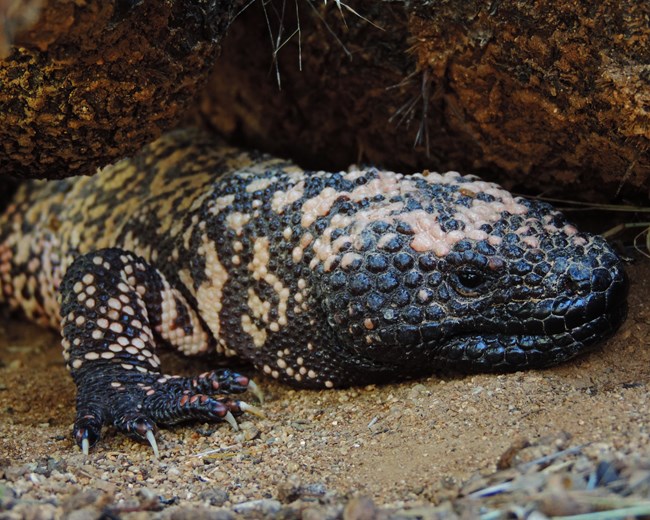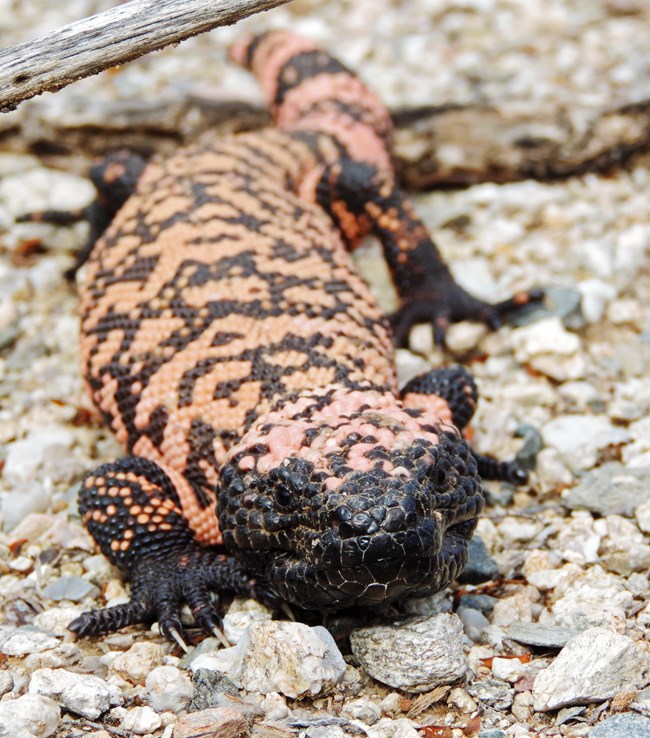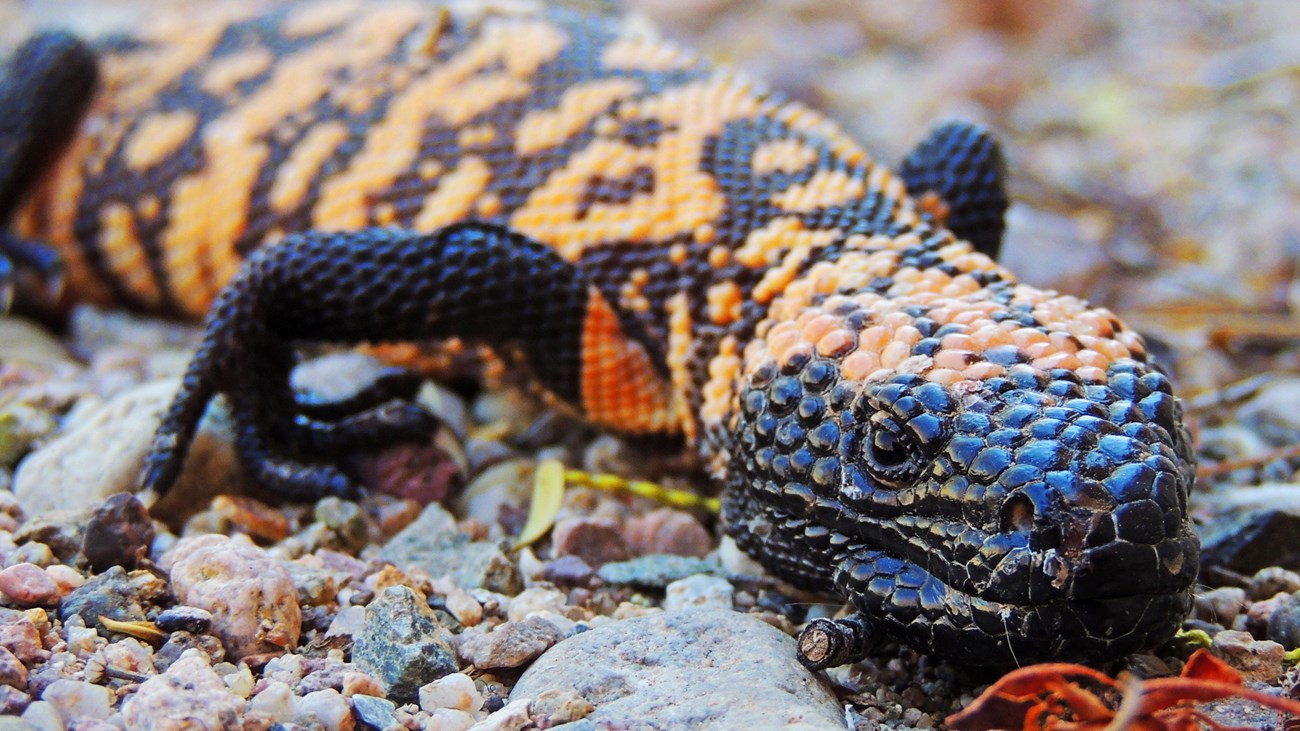
NPS photo Meet the MonsterThe Gila (pronounced HEE-lah) Monster (Heloderma suspectum) is one of the best known and most often asked about, but it is one of the rarest species to encounter of the Sonoran Desert reptiles. One of only two venomous lizards in North America, it is the only one found in the United States. (The other venomous species, the closely-related Beaded Lizard, is found from southern Sonora, Mexico, to Guatemala.) Folklore, tall tales and Hollywood movies have endowed the Gila Monster with powers and potency far beyond those possessed by any actual creature. But the facts about this unique lizard are fascinating and require no embellishment. Identifying CharacteristicsThe Gila Monster is the largest lizard in the United States. It grows to 22 inches (560 mm) long and can weigh over a pound. Its upper surface is covered with bead-like scales. It has a long, rounded body, a big head and a relatively short, rounded tail. Short, stout legs possess long toes with sharp claws used in digging and climbing. The snout is solid black, and it has an overall reticulated (netlike) or banded color pattern of black with pink, orange, salmon or yellowish. Natural HistoryGila monsters are primarily active during the day in early morning or late afternoon, although they can occasionally be found shortly after dark, particularly during the hottest weather. They are most often found out and about from March to May or June, but they may be seen abroad during any month of the year if conditions are to their liking. They may have a second, smaller peak in activity during the summer monsoon rainstorms. Gila Monsters are not rare, but they are not commonly seen as they spend the majority of their time underground. They may be out digging, hunting, basking, etc. on the surface for only a few hours of a few days per year; about 98% of the year is spent out of sight. They live in burrows, packrat nests, or caliche caves and dens, sometimes sharing their abodes with other reptiles such as snakes or desert tortoises. Distribution and HabitatThe Gila Monster is found in three of the four North American deserts. In the Sonoran Desert, it is found from southern arizona to northern Sinaloa, Mexico, in several habitats. At the outer edges of its distribution, it occurs in southwestern New Mexico (Chihuahuan Desert), southwestern Utah, the southern tip of Nevada, and short distance into eastern California (Mojave Desert). Two subspecies (geographical races) are recognized: the Reticulate Gila Monster, Heloderma suspectum suspectum, occurs from Sonora and extreme northwestern Sinaloa into southern Arizona and the southwestern corner of New Mexico. The Banded Gila Monster, H.s cinctum, occurs in the western and northwestern parts of Arizona with adjacent isolated populations in Utah, Nevada and California. 
ReproductionGila monsters usually lay 2 - 12 eggs from mid-July to mid-August, coinciding withthe start of the summer monsoon season. They eggs may overwinter underground or hatch with the young, staying in the burrow and emerging the following May after an approximately 130 day incubation period. At hatching, the newborn averages 6.5 inches long (165.3 mm) and about 1.2 ounces in weight (32.7 g). Even this is considerably larger than the size of an adult Banded Gecko (Coleonyx variegatus), a little, thin-skinned lizard with which it is sometimes confused. PredationGila Monsters have many potential predators such as coyotes, foxes, bobcats, hawks and owls. Young are more vulnerable to attack, and some predators dig up and eat the eggs. Adult Gila Monsters have little to fear. Their color and pattern warn of a potential danger and deter some predators. People are the Gila Monster's primary threat through collection, road kills, habitat loss and intentional killing. Venom and BitesThe venom of the Gila Monster is potent and painful, although seldom, if ever, fatal. Reports of deaths due to Gila Monster bites are rare, and most seem to be complicated by alcohol, drugs or other health factors. A reasonably healthy adult will probably not be killed by a bite, but young children and people with other medical concerns might be vulnerable. Gila Monsters produce venom in glands in their lower jaws. This is mixed with saliva and pulled into the wound along grooved teeth by capillary action. Thus, the longer the lizard hangs on, or "chews," the greater the amount of venom introduced. This is why Gila Monsters have the reputation of "hanging on like a bulldog." Their grip can be released by inserting a knife blade, credit card, stick, or other hard object between their teeth and the skin. Most Gila Monster bites, however, occur to people who try to handle the lizard. Reasonably cautious people who watch where they put their hands and feet will not be bitten by a Gila Monster. ProtectionGila Monsters are protected by state law in each of the states where they occur: California, Nevada, Utah, New Mexico and Arizona, the first state to protect it and the first venomous reptile offered protection in the United States. It is also fully protected in Mexico. In Saguaro National Park, all plant and animal life, as well as geological and cultural resources, are strictly protected. If you are lucky enough to see a Gila Monster in its natural habitat, enjoy the sighting, take photos, but do not attempt to touch or otherwise bother it. The best thing you can do for Gila Monsters is to educate yourself, you family and your friends about the desert and its amazing animal life. 
Gila Monster Project
The park encourages visitors to take pictures of Gila monsters they see while hiking. Park staff uses this data to monitor them over time. |
Last updated: May 5, 2025
